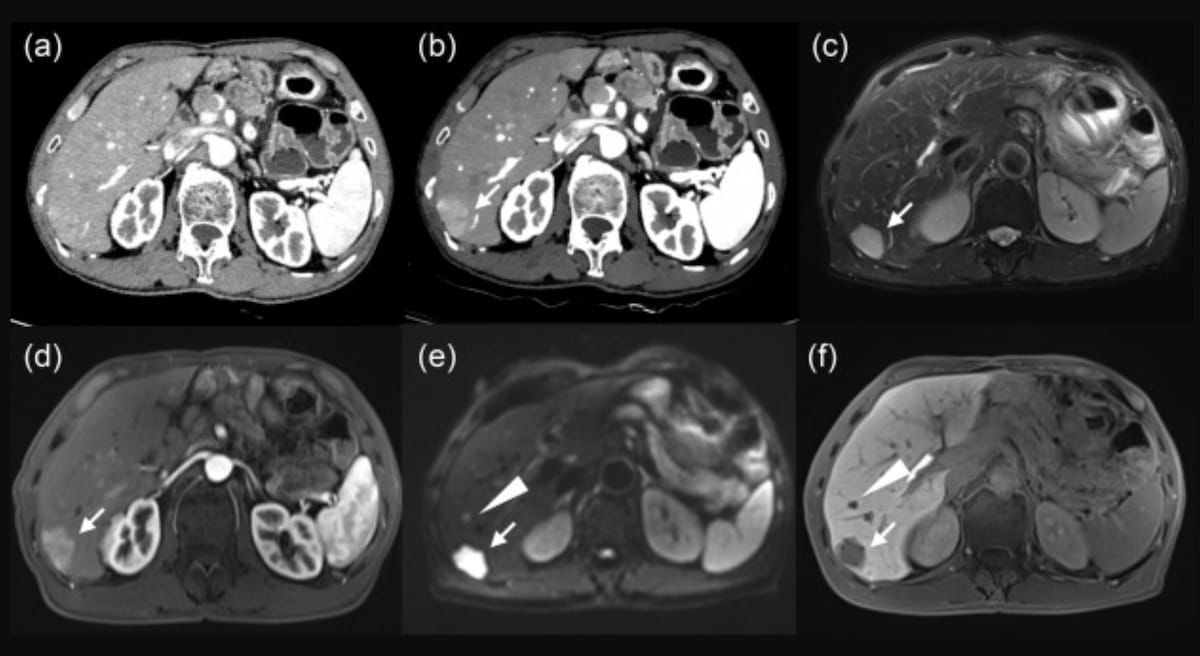The use of gadolinium ethoxybenzyl-diethylenetriaminepentaacetic acid (Gd-EOB-DTPA) enhanced magnetic resonance imaging (MRI) offers the best sensitivity for detecting neuroendocrine tumor liver metastases (NETLMs), according to a new comparative study.
For the retrospective study, recently published in the European Journal of Radiology, researchers compared Gd-EOB-DTPA-enhanced MRI with polyenergetic computed tomography (CT) and dual-layer spectral detector CT (DLCT) for the detection of NETLM. The study cohort was comprised of 72 patients with suspected NETLM who had abdominal DLCT and Gd-EOB-DTPA-enhanced MRI exams. Out of 477 identified lesions, the study authors noted that 396 lesions were metastatic.
The researchers found that Gd-EOB-DTPA-enhanced MRI offered a 95 percent sensitivity rate for diagnosing NETLM in comparison to 86 percent for DLCT and 76 percent for polyenergetic CT. Gd-EOB-DTPA-enhanced MRI also had a per-lesion area under the curve (AUC) of 97 percent in contrast to 91 percent for DLCT and 86 percent for polyenergetic CT, according to the study authors.
“The multiple functional imaging sequences (represent) the main advantage of Gd-EOB-DTPA-enhanced MR. (Neuroendocrine tumors are) pathologically characterized by high cellular density and nuclear/cytoplasmic volume ratio, and diffusion of water molecules is highly restricted within the tumor. As a result, DWI is highly sensitive to NETLM detection,” wrote lead study author Tiansong Xie, M.D., who is affiliated with the Department of Radiology at the Fudan University Shanghai Cancer Center in Shanghai, China, and colleagues.
While there were no significant differences between the imaging modalities for NETLM lesions > 10 mm, the study authors pointed out that Gd-EOB-DTPA-enhanced MRI had a significantly higher sensitivity rate for NETLM lesions < 10 mm (94 percent) in comparison to DLCT (80 percent) and polyenergetic CT (66 percent).
“The (hepatobiliary phase) of the Gd-EOB-DTPA-enhanced MR has been reported to exhibit best tumor–liver interface and highest (contrast-to-noise ratio) CNR in NETLM detection compared to other sequences,” added Xie and colleagues.
Three Key Takeaways
1. Higher sensitivity for small lesions. Gd-EOB-DTPA-enhanced MRI showed a significantly higher sensitivity (94 percent) for detecting NETLM lesions smaller than 10 mm compared to dual-layer spectral detector CT (80 percent) and polyenergetic CT (66 percent).
2. Superior diagnostic accuracy. Gd-EOB-DTPA-enhanced MRI achieved a 95 percent sensitivity rate and a 97 percent area under the curve (AUC) for diagnosing NETLM, outperforming DLCT (86 percent sensitivity, 91 percent AUC) and polyenergetic CT (76 percent sensitivity, 86 percent AUC).
3. Limitations of Gd-EOB-DTPA-enhanced MRI. While Gd-EOB-DTPA-enhanced MRI offers superior tumor-liver interface imaging and higher contrast-to-noise ratio (CNR), its use is limited by high costs, time-consuming acquisition, and potential inaccuracies in patients with liver dysfunction, particularly those undergoing chemotherapy for liver metastases. These factors may affect its clinical utility in certain patient populations.
However, the researchers cautioned that in addition to the high cost and time-consuming acquisition of Gd-EOB-DTPA-enhanced MRI, this imaging modality can be adversely affected by liver dysfunction in patients currently being treated with chemotherapy for liver metastases.
The study authors also noted that virtual monoenergetic imaging at 40 kiloelectron voltage (keV) offered a higher signal-to-nose ratio (SNR) and CNR in comparison to polyenergetic CT. In the arterial phase, the researchers noted the use of VMI at 40 keV more than doubled the SNR in contrast to polyenergetic CT (16.28 vs. 7.85) and more than tripled the CNR (5.49 vs. 1.47).
(Editor’s note: For related content, see “MRI Accurately Stages Cervical Neuroendocrine Carcinoma,” “New Radiopharmaceutical Offers Better Tumor Imaging and Staging for Patients with Liver Cancer” and “Emerging Model with Key MRI Feature Improves Prediction for Advanced Recurrence of Hepatocellular Carcinoma.”)
In regard to study limitations, the authors noted the retrospective study design and a reference standard based on imaging interpretation and pathological information. The researchers also noted possible patient selection bias with respect to high suspicion of liver metastases in patients who had DLCT and Gd-DTPA-enhanced MRI exams.
